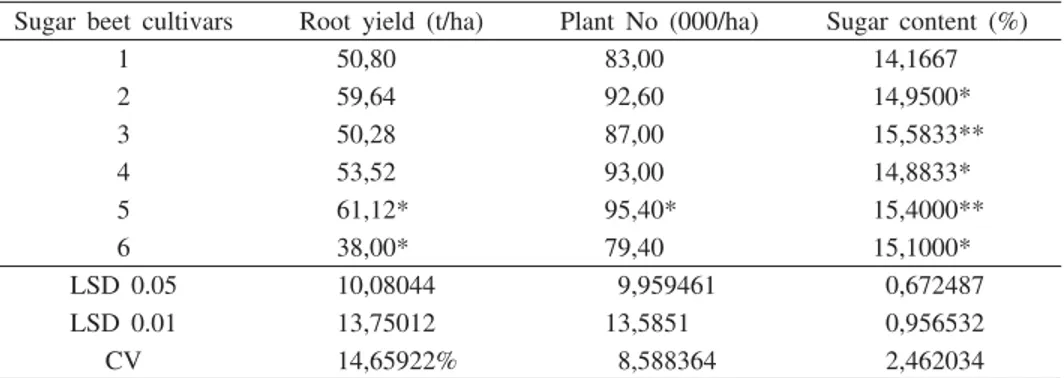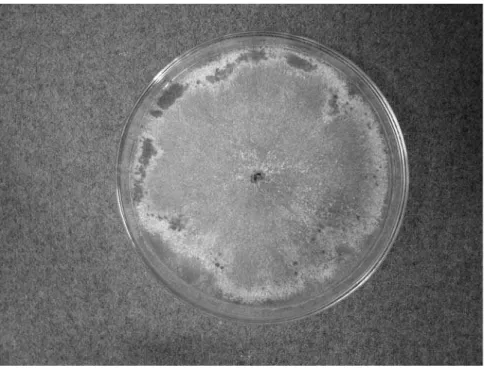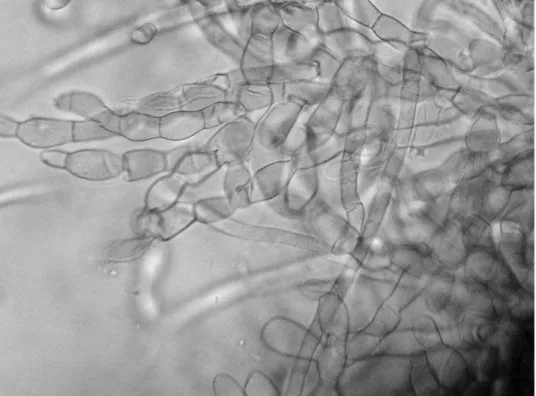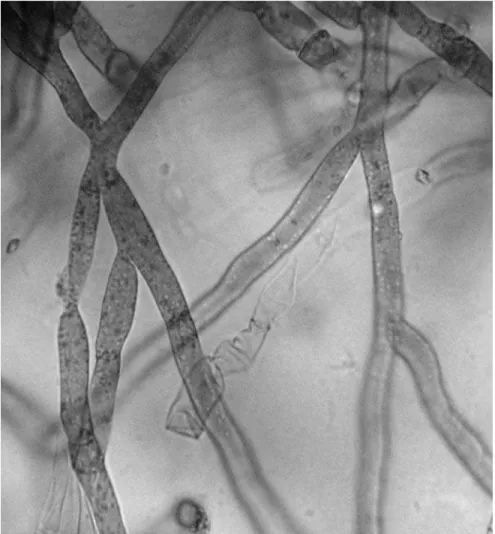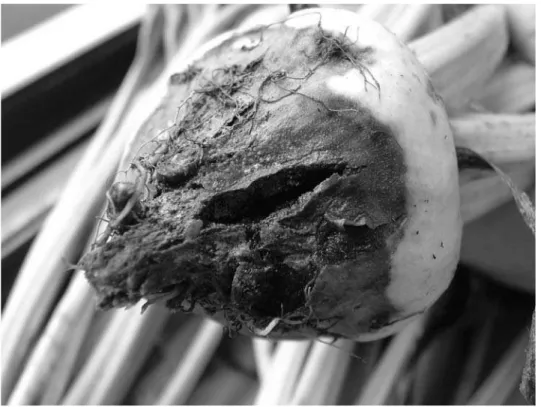Zbornik Matice srpske za prirodne nauke / Proc. Nat. Sci, Matica Srpska Novi Sad,
¥110, 109—121, 2006
UDC 633.63:632.4(497.113 Srem)
I v a n a M. V i c o1, D r a g i c a B. J a n k o v i ã2, B r a n k a B. K r s t i ã1, A l e k s a n d r a R. B u l a j i ã1, N a t a š a D. D u k i ã1
1 Faculty of Agriculture, Sv. Dimitrije 22
11000 Belgrade—Zemun, Serbia and Montenegro 2 Agricultural Institute “Dr Petar Drezgiã", Nemanjina 6
22000 Sremska Mitrovica, Serbia and Montenegro
MULTINUCLEATE
RHIZOCTONIA
SP. — PATHOGEN OF
SUGAR BEET AND SUSCEPTIBILITY OF CULTIVARS
UNDER FIELD CONDITIONS*
ABSTRACT: Sugar beet root rot has severely occurred in our country recently, espe-cially in localities of Pazova, Peãinci, Ruma, Sremska Mitrovica and Šid. From diseased ro-ots as well as from soil collected from the localities where decay occurred, fungal isolates were obtained by bait plant method. Based on their characteristics, they were identified as multinucleateRhizoctonia sp.
During the year of 2004 in Mitrosrem trial field T-11, where the presence of multi-nucleateRhizoctoniasp. was confirmed, an experiment under the coordination of Commit-tee for Acknowledgement and Registration of New Cultivars in our country was conducted in order to determine cultivars' tolerance, i.e. their susceptibility and possibility for growing on infested fields. Six cultivars of sugar beet, Laetitia (as standard) and five new ones were included in the investigation. The trial was conducted in accordance with the established and accepted method (Ministry of Agriculture, Forestry and Water Resources, Republic of Serbia). Susceptibility of investigated cultivars was evaluated according to significant pro-duction characteristics: root yield, sugar content, corrected sugar content, thick juice Q, mo-lasses sugar, content of K, Na and amino-N, polarized sugar yield and white sugar yield, as it was recommended by the method.
Conducted investigations have revealed that tested sugar beet cultivars showed diffe-rent reactions to natural infection with multinucleateRhizoctonia sp. Concerning root yield
as the most important agricultural characteristic, statistically significantly higher yield was obtained with the cultivar under code mark 5 (61.120 kg/ha), whereas the cultivar marked under code 6 had significantly lower yield comparing to the standard (38.100 kg/ha).
KEY WORDS: multinucleate Rhizoctonia sp., natural infection, tolerant cultivars, yield
INTRODUCTION
Rhizoctonia solani is the most studied species of Rhizoctonia genus and was described for the first time on potato in 1858 (S n e h et al., 1991). Based on the number of nuclei in their cells, fungi belonging to Rhizoctoniaspp. can be divided in two groups: binucleate and multinucleate. Species described as Rh. solani has more than three nuclei in its cells, thus this species belongs to the group of multinucleate Rhizoctonia sp. According to new criteria in the taxonomy of Rhizoctonia, it is recommended to describe Rh. solani as multi-nucleate Rhizoctonia sp. (S n e h et al., 1996).
Multinucleate Rhizoctonia sp. is economically important for growing on numerous plant hosts worldwide and in our country it is common on potato, beans, alfalfa (V i c o et al., 1996), tomato, cabbage (I v a n o v i ã and I v a -n o v i ã, 2001) a-nd or-name-ntals (V i c o et al., 2005). Besides me-ntio-ned hosts, in several localities in our country, this fungus is proved to be causing sugar beet root rot (V i c o et al., 2004).
In localities of Pazova, Peãinci, Ruma, Sremska Mitrovica and Šid, mas-sive decay of sugar beet has been observed. From diseased roots, as well as from the soil originating in these localities, fungus was isolated using plant ba-it method and was identified as multinucleate Rhizoctonia sp., based on some of its characteristics (V i c o et al., 2004). This fungus can survive as sclerotia or mycelia on plant debris in infested soil for a very long period (S c h e i d e r and W h i t n e y, 1986). Since it is polifagous, attacking numerous plant hosts, its inoculum accumulates in the soil although crop rotation is employed. In these conditions, after multinucleate Rhizoctonia sp. is registered in a certain locality, the only economically justified and available control measure is gro-wing resistant or tolerant cultivars (H a r v e s o n, 2003).
The aim of described investigations was to examine reactions of some su-gar beet cultivars to natural infection in order to evaluate their capacity for growing on soil infested by multinucleate Rhizoctonia sp.
MATERIAL AND METHODS
During 2003, on Mitrosrem field in Glac locality, near Sremska Mitrovi-ca, where sugar beet rot had been noticed in previous years, five soil samples were collected. These samples, each consisting of 1 kg of soil, were investiga-ted for the presence of plant pathogenic fungi using bait method (F o x, 1993). Soil was placed in appropriate pots and sowed with sugar beet, cv. Dana. Af-ter seedlings had emerged in greenhouse conditions, symptoms were observed each day. Greenhouse and phytopatological investigations were conducted in the facilities of Department of Phytopathology, Faculty of Agriculture, Belgra-de, Zemun.
dark. After fungi were developed around the plant fragments, a colony frag-ment was transferred, first on fresh PDA and afterwards on water agar (WA) where hyphal tip isolates were obtained.
In order to identify the obtained fungal isolates, macroscopic and micro-scopic morphological, as well as some biological characteristics were investi-gated. Colony appearance and characteristics like shape, dimensions and cha-racteristics of spores and mycelia, as well as the number of nuclei in cells were studied. On seven days old fungal colonies on PDA, incubated at 24°C in dark, macroscopic properties of isolates were studied, following the criteria proposed by M u n t a n o l a - C v e t k o v i ã (1987). Studied properties were growth rate, colony appearance, colony edge characteristics, colour, the presen-ce of fructifying bodies, exudation, spresen-cent and pigmentation. Seven days old fungal colonies on PDA and WA were used for observing and studying micro-scopic characteristics. Studied micromicro-scopic properties were mycelia appearan-ce, hyphal appearanappearan-ce, branching and septation, characteristics of septae, spo-rulation, as well as the appearance of myceliar bodies. Hyphal width and the length from the branching point to the first septae and dimensions of spores and myceliar bodies were measured. The number of nuclei per cell in obtained isolates was investigated applying two methods: shafranin O staining (B a n -d o n i, 1979) an-d staining with aniline blue in lactophenol (0,5% solution) ( B u r p e e et al., 1978). The number of nuclei per cell was determined in 100 randomly selected hyphal or moniliformous cells in seven days old cultu-res of investigated isolates, grown on PDA and WA media.
RESULTS
Symptoms on bait plants and identification of fungi
On diseased sugar beet seedlings, 7—10 days after emerging, damping off occurred as the result of root and crown necrosis (Figure 1). From diseased bait plants with symptoms of necrosis, fungus was isolated on PDA. After ob-taining hyphal tip cultures, the identification was carried out.
Isolates expressed following macroscopic characteristics: beige to brown colonies, rich and well developed showing rapid growth (average 24,55 mm per day); edge uninterrupted and smooth; mycelium developed on the glass; sclerotia (numerous, thick, spherical, light to dark brownish, usually in groups, 0,5—3 mm in diameter) were formed superficially in the colonies, 5—6 days after transferring to PDA and usually distributed near colony edge (Figure 2).
Microscopic properties of investigated isolates were: mycelia wavy and multicelullar; young hyphae branching under almost right angle; at the bran-ching point, where lateral hyphae began to grow, there was a characteristic narrow point near which septae could be found on the lateral branch (Figure 3); moniliformous cells appeared in long chains (Figure 4). Hyphal width was from 5,5—7,5 mm, hyphal length from the branching point to the first septae was 4,7—7,5 mm, hyphal width at the narrow point was 4,5 mm on average.
Symptoms during vegetation
During the field trial, complete plant decay was found in some sugar beet cultivars. On a few of the remaining plants there were symptoms of rot which could be seen during harvesting, at the end of the experiment. Symptoms on mature plants were dark brown necrosis and superficial root splitting (Figure 6). Necrosis and rot were spreading towards root core. Plant decay and root rot were observed in different intensity on investigated sugar beet cultivars. Du-ring root harvesting, a similar number of 1—4 rotted roots per replicate was established with cultivars under codes 2, 4 and 5, while the cultivar under co-de 6 had 17—20 roots with symptoms. Nevertheless, all investigated sugar be-et cultivars expressed similar capability of finishing vegbe-etation in the soil infe-sted with multinucleate Rhizoctonia sp. (Figure 5). The number of harvested plants was not statistically different comparing to the standard. The only exception was the cultivar under code 5 where statistically significantlly higher number of plants completed the vegetation (Table 1).
Productional properties of investigated sugar beet cultivars
As it can be seen in Table 1, the highest yield was recorded for the culti-var under code 5 (61,120 kg/ha) and this was statistically significantlly higher comparing to the standard, cv. Laetitia, which was under code 1. The lowest yield was recorded for the cultivar under code 6 (38100 kg/ha) and this was statistically significantlly lower than the standard. The highest sugar content was found in the cultivar under code 3 (15,58%), followed by the cultivar un-der code 5 (15,40%). Both were statistically significantlly higher comparing to the standard. Remaining cultivars, 2, 4 and 6 also had statistically significantly higher sugar content comparing to Laetitia (14,17%). Concerning plant number per ha, the only statisticaly significant difference comparing to the standard was with the cultivar under code 5 where the higher number of plants mana-ged to complete vegetation (95400 plants/ha).
In Table 2, the remaining productional characteristics were summarized. Among these, the important ones are polarized sugar yield and white sugar yield which were the highest with the cultivar under code 5 (5418 and 7904 kg/ha, respectively) and the lowest with the cultivar under code 6 (5759 and 4830 kg/ha, respectively).
DISCUSSION
Obtained fungal isolates were identified as multinucleate Rhizoctonia sp. based on disease symptoms on bait plants, i.e. sugar beet seedlings, isolation and morphological properties as well as on the number of nuclei in the cells ( S n e h et al., 1991; C e r e s i n i, 1991). The presence of plant pathogenic fungi Rhizoctonia sp. was confirmed in the soil of Mitrosrem T-11 field, which made it appropriate for setting the cultivar experiment.
During vegetation, with all investigated sugar beet cultivars, necrosis and decay of smaller number of plants were established. Not all the plants that had been planted and then emerged, managed to complete vegetation. Multinuclea-teRhizoctonia sp. is the causal agent of necrosis and decay of sugar beet, cau-sing yield reduction by 2—30% (S c h e i d e r and W h i t n e y, 1986) and even up to 50% (G a l l i a n n, 1998). This yield reduction is greatly due to plant decay before harvesting. In the conditions of this experiment, with all in-vestigated sugar beet cultivars, a large number of plants was able to finish ve-getation, so all investigated cultivars posses a certain level of tolerance to-wards Rhizoctonia sp. and the capacity to be cultured in infested soil.
and H a n s o n (2003) recommend yield measurement and disease intensity assessment as tools for selecting tolerant sugar beet genotypes in the conditi-ons of natural infection. L e o n a r d (2003) examined the tolerance of sugar beet cultivars against multinucleate Rhizoctonia sp., but cultivar reaction was compared to a susceptible standard. In that way, the reaction of tolerant culti-vars was more obvious. Based on the results obtained in this investigation and comparing them to literature data, sugar beet cultivar under code 5 could be recommended for further evaluations, because it showed statistically signifi-cantly higher yield and statistically very signifisignifi-cantly higher sugar content than the standard.
Results obtained in conducted investigations showed that tolerant sugar beet cultivars are available and able to give satisfactory yield in the conditions of soil infestation with multinucleate Rhizoctonia sp. in our climate. Since the growing of tolerant sugar beet genotypes on infested soil is the only economi-cally justified control measure of sugar beet root rot caused by multinucleate Rhizoctonia sp., results obtained in presented investigations are significant for scientific as well as for practical aspects of sugar beet production.
ACKNOWLEDGEMENTS
Table 1. Major productional characteristics of investigated sugar beet cultivars naturally infected with multinucleate Rhizoctonia sp.during 2004.
Sugar beet cultivars Root yield (t/ha) Plant No (000/ha) Sugar content (%)
1 50,80 83,00 14,1667
2 59,64 92,60 14,9500*
3 50,28 87,00 15,5833**
4 53,52 93,00 14,8833*
5 61,12* 95,40* 15,4000**
6 38,00* 79,40 15,1000*
LSD 0.05 10,08044 9,959461 0,672487
LSD 0.01 13,75012 13,5851 0,956532
CV 14,65922% 8,588364 2,462034
Note:
* Statistically significant difference comparing to standard with LSD 0,05. ** Statistically significant difference comparing to standard with LSD 0,01.
Table 2. Other measured productional characteristics of investigated sugar beet cultivars naturally infected with multinucleate Rhizoctonia sp. during 2004.
Sugar-beet cultivars Corrected sugar content % Thick juice Q Molasses Sugar %
K Na Amino N Polarizedsugar yield 000 kg/ha White sugar yield 000 kg/ha mmol/100°S
1 11,28 90,68 2,29 30,05 20,66 10,14 7,120 5,668
2 11,66 92,54 1,69 25,09 10,72 11,95 8,915 7,548
3 13,46 93,63 1,52 23,11 8,85 8,22 7,833 6,769
4 12,44 92,42 1,84 24,41 15,15 9,07 7,963 6,657
5 12,92 92,51 1,88 24,36 14,74 8,90 9,418 7,904
Figure 1. Multinucleate Rhizoctonia sp.: Root necrosis of bait plants
Figure 3. Multinucleate Rhizoctonia sp.:
Junction point of branching hyphae
REFERENCE
B a n d o n i, R. J. (1979): Safranin O as a rapid stain for fungi, Mycologia 71:
873—874.
B u r p e e, L. L., S a n d e r s, P. L., C o l e, H. Jr. and K i m, S. H. (1978):A staining technique for nuclei of Rhizoctonia solani and related fungi, Mycologia 70:
1281—1283.
C e r e s i n i, P. (1999): Rhizoctonia solani, Pathogen profile in Course PP-728
Soil--borne Plant Pathogens, http://www.cnls.ncsu.edu/course/pp728/Rhizoctonia/Rhi-zoctonia.html.
F o x, R. T. V. (1993):Principles of diagnostic techniques in plant pathology, CAB
In-ternational, University Press, Cambridge, UK.
G a l l i a n n, J. J. (1998): Management of sugar beet root rots, University of Idaho,
Twin Falls Research and Extension Centre, http://www.uidaho.edu/sugarbeet/De-sease/rtdspnw.htm.
H a r v e s o n, B. (2003): Rhizoctonia Root/Crown Rot, Plant Disease Centre,
http://pdc.unl.edu/sugarbeet/RhizochtoniaRootAndCrownRot/text.htm.
I v a n o v i ã, M., I v a n o v i ã, D. (2001): Mikoze i pseudomikoze biljaka, Univerzitet
u Beogradu, Poljoprivredni fakultet, Beograd.
L e o n a r d, P. (2003):Forty years of breeding sugar beet for resistance to Rhizoctonia solani — where are we?, Western Society of Crop Science Proceedings, pp 1 (Abstr.) http://www.ars.usda.gov/research/publications/publicat ions.htm.
L e o n a r d, P., H a n s o n, L. (2003):USDA-ARS Sugar beet germplasm developed in Fort Collins, Co, Evaluated for Rhizoctonia resistance, 2002, Biological and
cul-tural test for control of plant diseases,
http://www.apsnet.org/online/BCtests/Vol18/top.htm.
M u n t a n o l a - C v e t k o v i ã, M. (1987): Opšta mikologija, NIRO „Knjiÿevne
novi-ne", Beograd.
S c h e i d e r, C. L., W h i t n e y, E. D. (1986): Rhizoctonia root and crown rot. In: Compendium of beet diseases and insectsed. by Whitney, E. D. and James, E. D.,
APS Press, St. Paul-Minnesota, USA, pp. 21.
S n e h, B., B u r p e e, L., O g o s h i, A., (1991):Identification of Rhizoctonia species, APS Press, St Paul-Minnesota, USA.
S n e h, B., J a b a j i - H a r e, S., N e a t e, S., D i j s t, G. (1996):Rhizoctonia species: Taxonomy, molecular biology, ecology, pathology and disease control, Kluwer
Academic Publishers, Dordrecht, Netherlands.
V i c o, Ivana, Branka K r s t i ã, Gordana S t o j a n o v i ã, G. G r e b o v i ã, M. T o -š i ã (1996):Prilog poznavanju etiologije propadanja lucerke (Contribution to the aetiology of alfalfa decay), Zbornik nauånih radova sa X meðunarodnog
savetova-nja agronoma i tehnologa, Aranðelovac, Feb. 1996. Vol. 2, br. 1: 193—201. V i c o, I., K r s t i ã, B., B u l a j i ã, A., D u k i ã, N. (2005):Višejedarna Rhizoctonia
sp. — patogen hrizanteme. Pesticidi i fitomedicina, Privredni pregled, Beograd (In press).
V i c o, I., K r s t i ã, B., J a n k o v i ã, D., B u l a j i ã, A., Z i n d o v i ã, J. i N. D u -k i ã (2004):Etiologija propadanja šeãerne repe u Srbiji, V Kongres o zaštiti
VIŠEJEDARNA RHIZOCTONIA SP. — PATOGEN ŠEÃERNE REPE I OSETQIVOST SORTI U POQU
Ivana M. Vico1, Dragica B. Jankoviã2, Branka B. Krstiã1,
Aleksandra R. Bulajiã1, Nataša D. Dukiã1 1 Poqoprivredni fakultet, Nemawina 6,
11000 Beograd—Zemun, Srbija i Crna Gora
2 Poqoprivredni institut „Dr Petar Drezgiã", Sv. Dimitrija 22,
22000 Sremska Mitrovica, Srbija i Crna Gora
Rezime
Posledwih godina uoåeno je masovno propadawe šeãerne repe u našoj ze-mqi i to u lokalitetima Pazove, Peãinaca, Rume, Sremske Mitrovice i Šida. Iz obolelih korenova i iz zemqišta prikupqenog sa terena gde je propadawe uoåeno, metodom mamaka izolovana je gqiva koja je po svojim osobinama identi-fikovana kao višejedarna Rhizoctonia sp.
U toku 2004. godine na parceli Mitrosrema T-11, gde je izolacijom doka-zano prisustvo višejedarneRhizoctonia sp., postavqen je ogled u okviru sortne komisije za priznavawe i registraciju novih sorti u našoj zemqi sa ciqem utvrðivawa tolerantnosti, odnosno osetqivosti pojedinih sorti i time wiho-ve pogodnosti za gajewe na infestiranom zemqištu. U ispitivawa je ukquåeno 6 sorti šeãerne repe: Laetitia (kao standard) i još pet novih sorti. Ogled je posejan po utvrðenoj i prihvaãenoj metodi sortne komisije (Ministarstvo po-qoprivrede, šumarstva i vodoprivrede Republike Srbije). Osetqivost ispiti-vanih sorti ocewivana je na osnovu znaåajnih proizvodnih osobina: prinos ko-rena, polarizacija, korigovani sadrÿaj šeãera,Qgustog soka, sadrÿaja seãera u melasi, sadrÿaja K, Na i amino N, prinos polarizacionog šeãera i prinos kristalnog šeãera, kako to metoda i zahteva.
